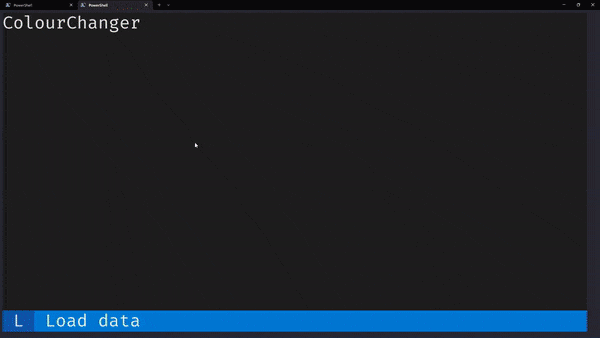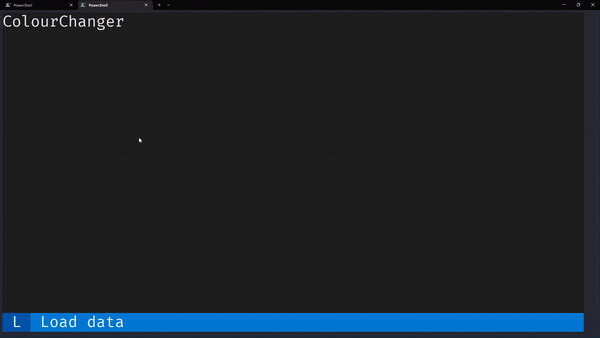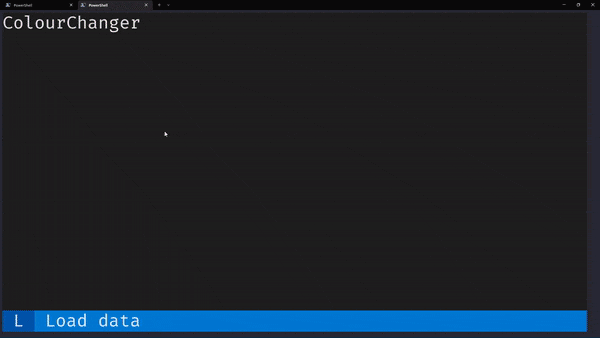Letting your cook multitask while bringing water to a boil¶
Whenever you are cooking a time-consuming meal, you want to multitask as much as possible. For example, you do not want to stand still while you wait for a pot of water to start boiling. Similarly, you want your applications to remain responsive (i.e., you want the cook to “multitask”) while they do some time-consuming operations in the background (e.g., while the water heats up).
The animation below shows an example of an application that remains responsive (colours on the left still change on click) even while doing a bunch of time-consuming operations (shown on the right).

In this blog post, I will teach you how to multitask like a good cook.
Wasting time staring at pots¶
There is no point in me presenting a solution to a problem if you don't understand the problem I am trying to solve. Suppose we have an application that needs to display a huge amount of data that needs to be read and parsed from a file. The first time I had to do something like this, I ended up writing an application that “blocked”. This means that while the application was reading and parsing the data, nothing else worked.
To exemplify this type of scenario, I created a simple application that spends five seconds preparing some data.
After the data is ready, we display a Label on the right that says that the data has been loaded.
On the left, the app has a big rectangle (a custom widget called ColourChanger) that you can click and that changes background colours randomly.
When you start the application, you can click the rectangle on the left to change the background colour of the ColourChanger, as the animation below shows:

However, as soon as you press l to trigger the data loading process, clicking the ColourChanger widget doesn't do anything.
The app doesn't respond because it is busy working on the data.
This is the code of the app so you can try it yourself:
import time
from random import randint
from textual.app import App, ComposeResult
from textual.color import Color
from textual.containers import Grid, VerticalScroll
from textual.widget import Widget
from textual.widgets import Footer, Label
class ColourChanger(Widget): # (1)!
def on_click(self) -> None:
self.styles.background = Color(
randint(1, 255),
randint(1, 255),
randint(1, 255),
)
class MyApp(App[None]):
BINDINGS = [("l", "load", "Load data")] # (2)!
CSS = """
Grid {
grid-size: 2;
}
"""
def compose(self) -> ComposeResult:
yield Grid(
ColourChanger(),
VerticalScroll(id="log"),
)
yield Footer()
def action_load(self) -> None: # (3)!
time.sleep(5) # (4)!
self.query_one("#log").mount(Label("Data loaded ✅"))
MyApp().run()
- The widget
ColourChangerchanges colours, randomly, when clicked. - We create a binding to the key
lthat runs an action that we know will take some time (for example, reading and parsing a huge file). - The method
action_loadis responsible for starting our time-consuming task and then reporting back. - To simplify things a bit, our “time-consuming task” is just standing still for 5 seconds.
I think it is easy to understand why the widget ColourChanger stops working when we hit the time.sleep call if we consider the cooking analogy I have written about before in my blog.
In short, Python behaves like a lone cook in a kitchen:
- the cook can be clever and multitask. For example, while water is heating up and being brought to a boil, the cook can go ahead and chop some vegetables.
- however, there is only one cook in the kitchen, so if the cook is chopping up vegetables, they can't be seasoning a salad.
Things like “chopping up vegetables” and “seasoning a salad” are blocking, i.e., they need the cook's time and attention.
In the app that I showed above, the call to time.sleep is blocking, so the cook can't go and do anything else until the time interval elapses.
How can a cook multitask?¶
It makes a lot of sense to think that a cook would multitask in their kitchen, but Python isn't like a smart cook.
Python is like a very dumb cook who only ever does one thing at a time and waits until each thing is completely done before doing the next thing.
So, by default, Python would act like a cook who fills up a pan with water, starts heating the water, and then stands there staring at the water until it starts boiling instead of doing something else.
It is by using the module asyncio from the standard library that our cook learns to do other tasks while awaiting the completion of the things they already started doing.
Textual is an async framework, which means it knows how to interoperate with the module asyncio and this will be the solution to our problem.
By using asyncio with the tasks we want to run in the background, we will let the application remain responsive while we load and parse the data we need, or while we crunch the numbers we need to crunch, or while we connect to some slow API over the Internet, or whatever it is you want to do.
The module asyncio uses the keyword async to know which functions can be run asynchronously.
In other words, you use the keyword async to identify functions that contain tasks that would otherwise force the cook to waste time.
(Functions with the keyword async are called coroutines.)
The module asyncio also introduces a function asyncio.create_task that you can use to run coroutines concurrently.
So, if we create a coroutine that is in charge of doing the time-consuming operation and then run it with asyncio.create_task, we are well on our way to fix our issues.
However, the keyword async and asyncio.create_task alone aren't enough.
Consider this modification of the previous app, where the method action_load now uses asyncio.create_task to run a coroutine who does the sleeping:
import asyncio
import time
from random import randint
from textual.app import App, ComposeResult
from textual.color import Color
from textual.containers import Grid, VerticalScroll
from textual.widget import Widget
from textual.widgets import Footer, Label
class ColourChanger(Widget):
def on_click(self) -> None:
self.styles.background = Color(
randint(1, 255),
randint(1, 255),
randint(1, 255),
)
class MyApp(App[None]):
BINDINGS = [("l", "load", "Load data")]
CSS = """
Grid {
grid-size: 2;
}
"""
def compose(self) -> ComposeResult:
yield Grid(
ColourChanger(),
VerticalScroll(id="log"),
)
yield Footer()
def action_load(self) -> None: # (1)!
asyncio.create_task(self._do_long_operation()) # (2)!
async def _do_long_operation(self) -> None: # (3)!
time.sleep(5)
self.query_one("#log").mount(Label("Data loaded ✅"))
MyApp().run()
- The action method
action_loadnow defers the heavy lifting to another method we created. - The time-consuming operation can be run concurrently with
asyncio.create_taskbecause it is a coroutine. - The method
_do_long_operationhas the keywordasync, so it is a coroutine.
This modified app also works but it suffers from the same issue as the one before!
The keyword async tells Python that there will be things inside that function that can be awaited by the cook.
That is, the function will do some time-consuming operation that doesn't require the cook's attention.
However, we need to tell Python which time-consuming operation doesn't require the cook's attention, i.e., which time-consuming operation can be awaited, with the keyword await.
Whenever we want to use the keyword await, we need to do it with objects that are compatible with it.
For many things, that means using specialised libraries:
- instead of
time.sleep, one can useawait asyncio.sleep; - instead of the module
requeststo make Internet requests, useaiohttp; or - instead of using the built-in tools to read files, use
aiofiles.
Achieving good multitasking¶
To fix the last example application, all we need to do is replace the call to time.sleep with a call to asyncio.sleep and then use the keyword await to signal Python that we can be doing something else while we sleep.
The animation below shows that we can still change colours while the application is completing the time-consuming operation.
import asyncio
from random import randint
from textual.app import App, ComposeResult
from textual.color import Color
from textual.containers import Grid, VerticalScroll
from textual.widget import Widget
from textual.widgets import Footer, Label
class ColourChanger(Widget):
def on_click(self) -> None:
self.styles.background = Color(
randint(1, 255),
randint(1, 255),
randint(1, 255),
)
class MyApp(App[None]):
BINDINGS = [("l", "load", "Load data")]
CSS = """
Grid {
grid-size: 2;
}
"""
def compose(self) -> ComposeResult:
yield Grid(
ColourChanger(),
VerticalScroll(id="log"),
)
yield Footer()
def action_load(self) -> None:
asyncio.create_task(self._do_long_operation())
async def _do_long_operation(self) -> None:
self.query_one("#log").mount(Label("Starting ⏳")) # (1)!
await asyncio.sleep(5) # (2)!
self.query_one("#log").mount(Label("Data loaded ✅")) # (3)!
MyApp().run()
- We create a label that tells the user that we are starting our time-consuming operation.
- We
awaitthe time-consuming operation so that the application remains responsive. - We create a label that tells the user that the time-consuming operation has been concluded.

Because our time-consuming operation runs concurrently, everything else in the application still works while we await for the time-consuming operation to finish.
In particular, we can keep changing colours (like the animation above showed) but we can also keep activating the binding with the key l to start multiple instances of the same time-consuming operation!
The animation below shows just this:

Warning
The animation GIFs in this blog post show low-quality colours in an attempt to reduce the size of the media files you have to download to be able to read this blog post. If you run Textual locally you will see beautiful colours ✨
